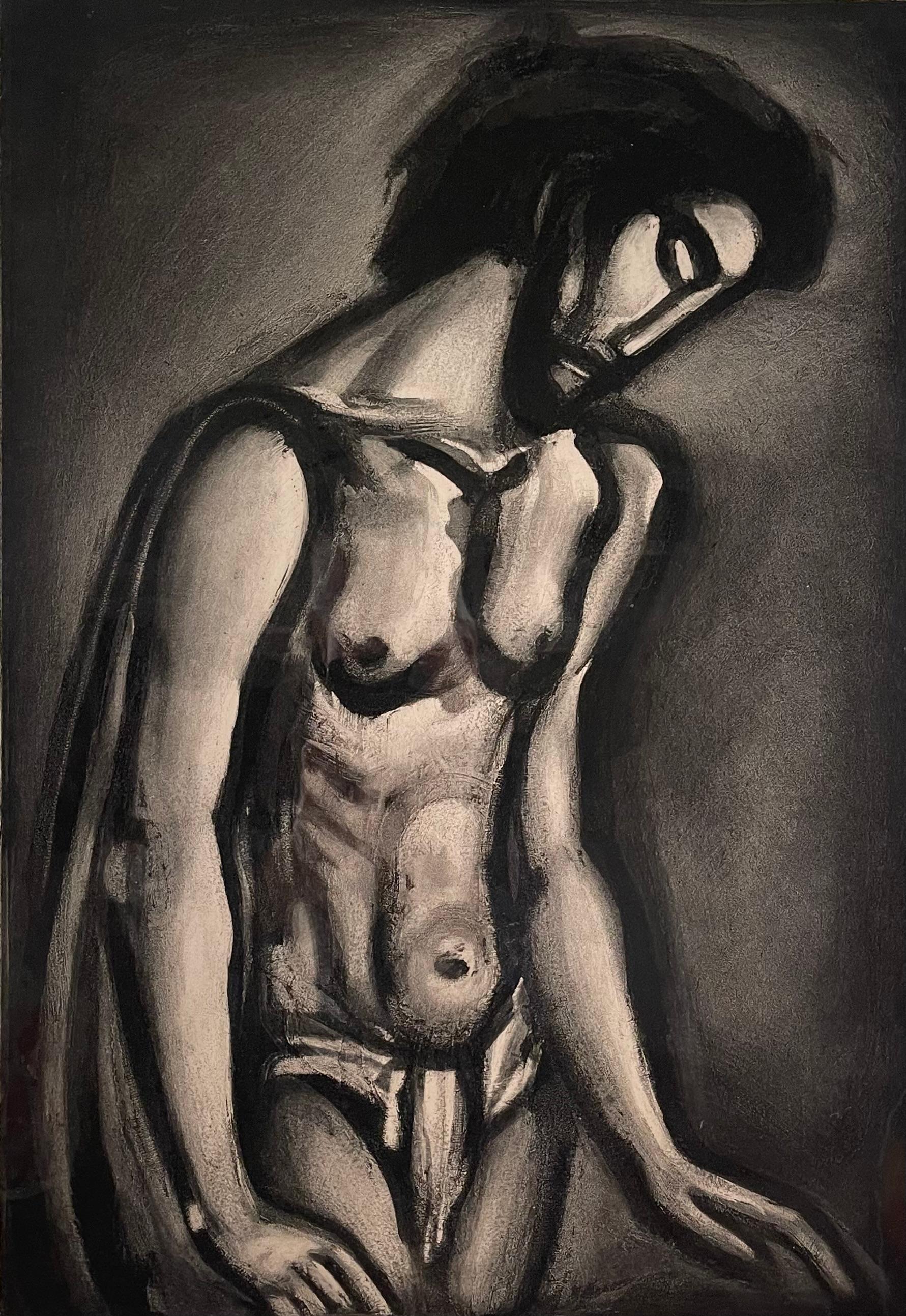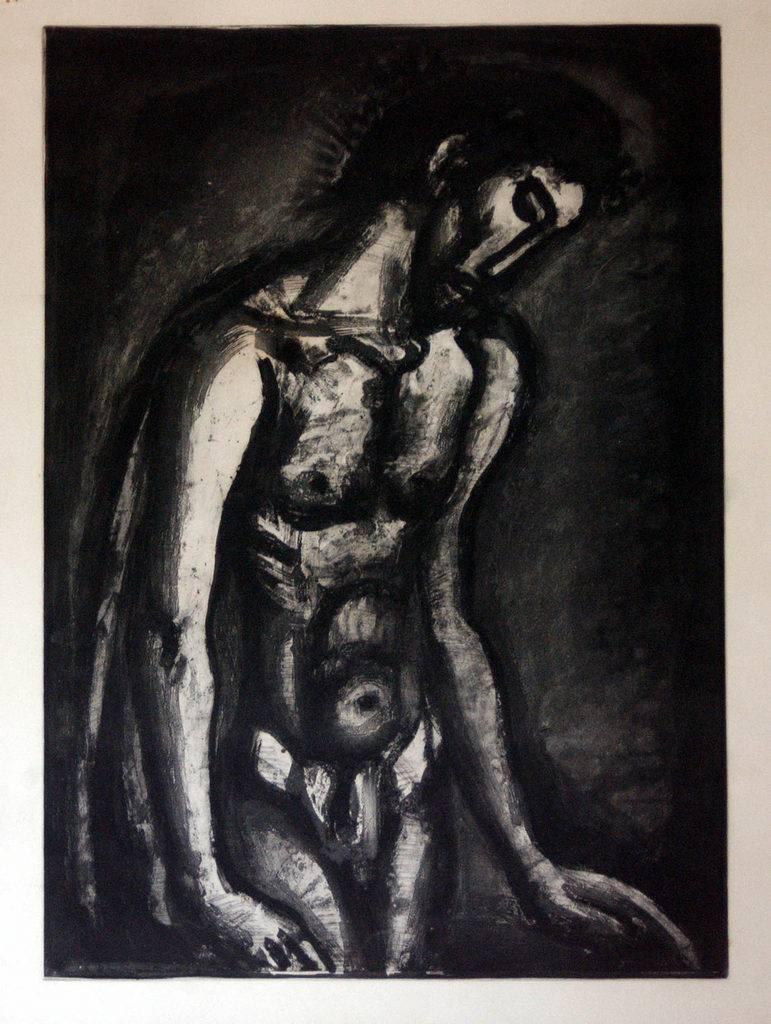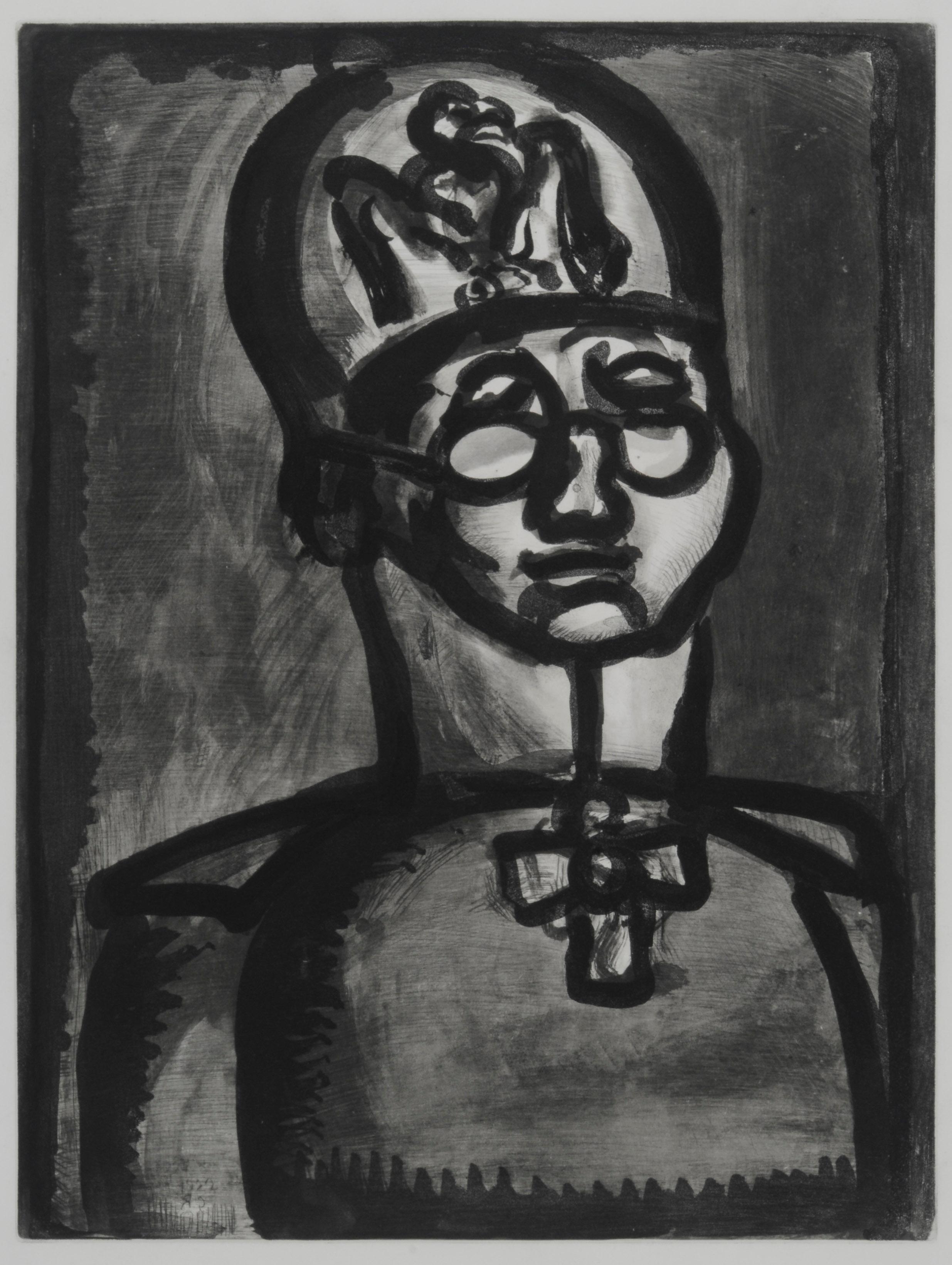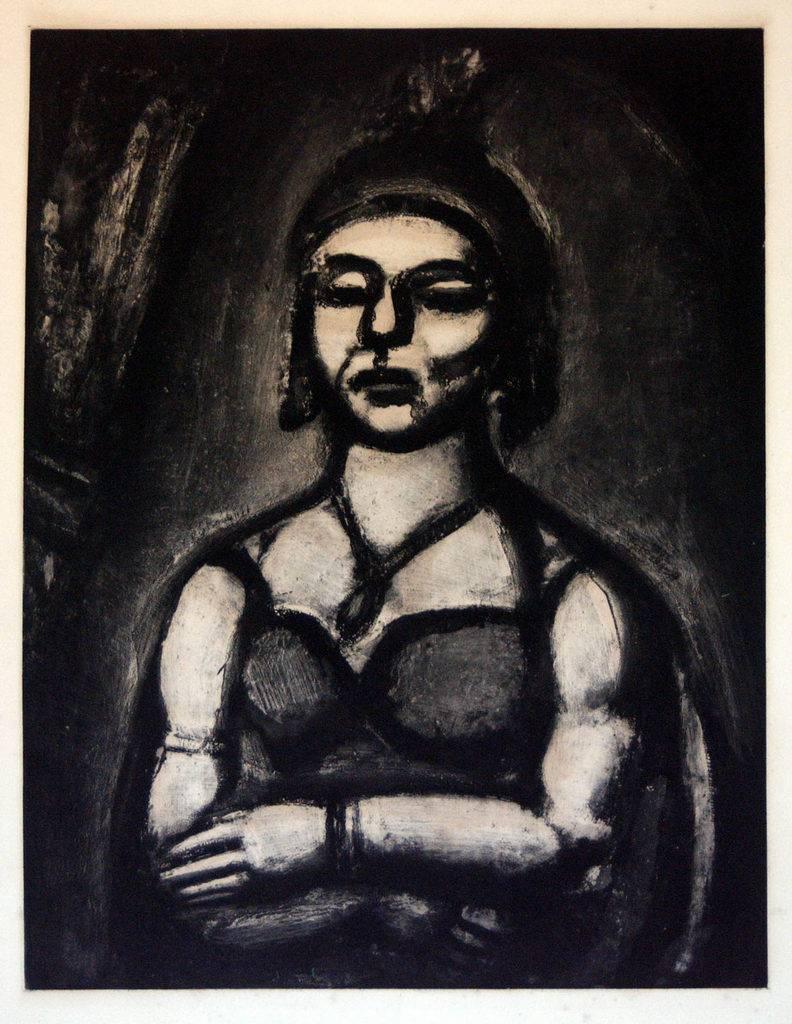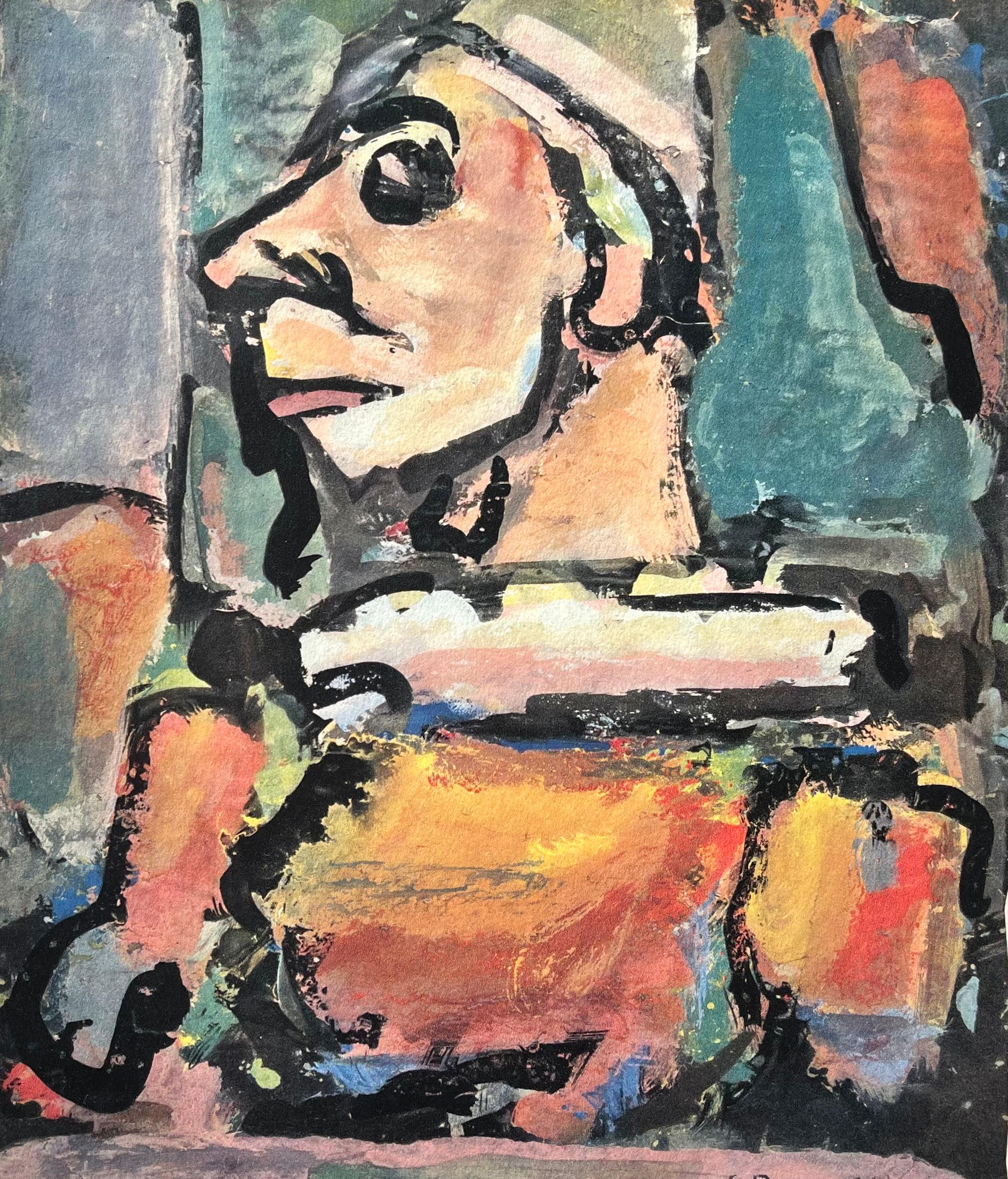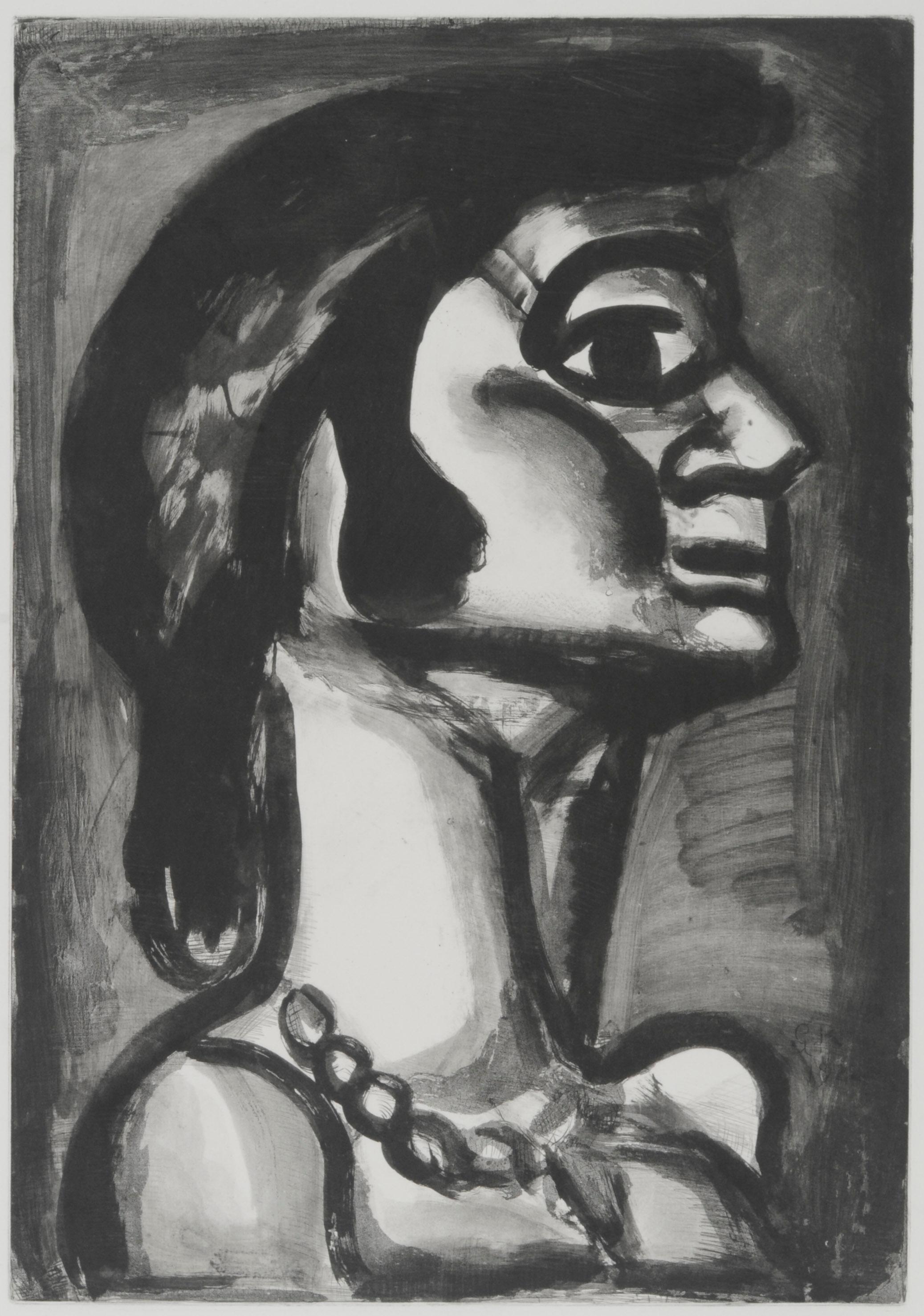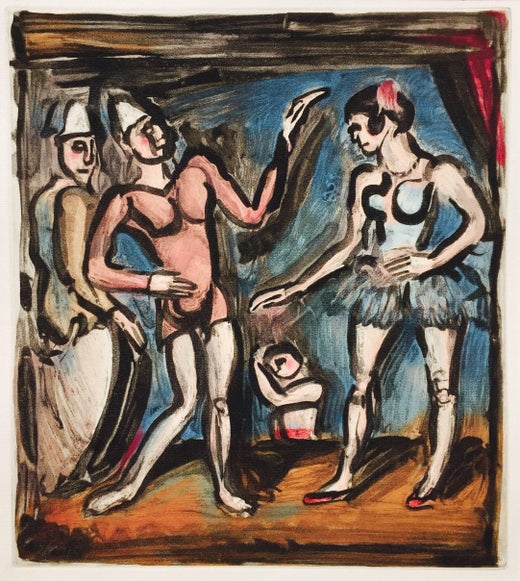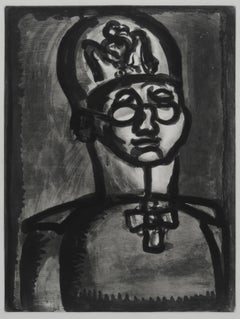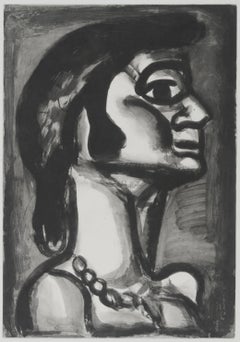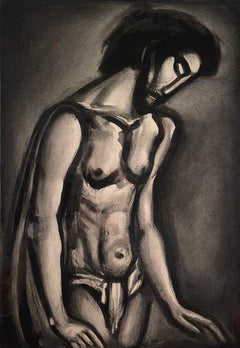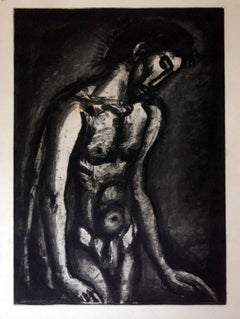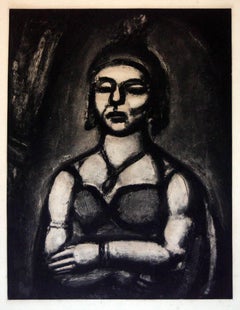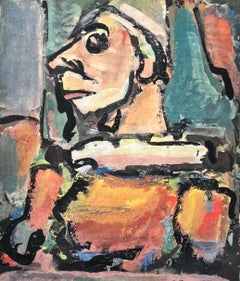Items Similar to Qui ne se grime pas? (Who does not wear a mask?)
Want more images or videos?
Request additional images or videos from the seller
1 of 12
Georges RouaultQui ne se grime pas? (Who does not wear a mask?)1923
1923
$8,500
£6,485.73
€7,378.01
CA$11,936.75
A$13,063.34
CHF 6,902.83
MX$155,919.61
NOK 88,088.70
SEK 80,564.28
DKK 55,109.87
About the Item
Qui ne se grime pas?
(Who does not wear a mask?)
Aquatint, roulette, drypoint, acid bite, and scorper, 1923
Signed in the plate loweer left (see photo)
Dated in pencil
Series: Miserere et Guerre, Plate 8
Edition: 450 printed in 1948 for Editions de L'Etoile Filante, Paris
Printed on Arches watermark paper
One the famous prints of the first half of the 20th century. It is reproduced in many survey books on printmaking.
Condition: Excellent
Archival cleaning performed
Image/Plate: 22 1/8 x 16 3/4" (56.2 x 42.55 cm)
Sheet size: 25 1/2 x 19 7/8 inches
Reference: Chapon & Rouault 61C
Wofsy 115
The project was originally started by Ambrose Vollard who completed the printing of the plates in 1928. The actual portfolio was published in 1948 by Editions de l'Etoile Filante, Paris. This is the most famous image of the series and is considered an iconic 20th century print.
Cost lowered to adjust for insurance settlement payment
Rouault’s Miserere (Mercy) series, first titled Miserere et Guerre (Mercy and War), was commissioned in 1916 by art dealer Ambroise Vollard (1865–1939). Originally planned as a two-volume book comprised of 50 prints each, Miserere was only partially realized — with 58 prints published in 1948. The series illustrates man’s cruelty to man, relates human suffering to the passion of Christ, and speaks to the redemption and salvation that can be achieved through that experience.” Haggerty Museum of Art
‘Rouault began his Miserere series during the somber days of World War I and had finished it by 1927. He first drew the images in India ink and later reproduced them as engravings, reworking the plates over the years—scraping deeper with a file or sanding with emery paper.
He later wrote of this time: “When I was about thirty, I felt a stroke of lightning, or of grace, depending on one’s perspective. The face of the world changed for me. I saw everything that I had seen before, but in a different form and with a different harmony.”
“Rouault was born into a poor family in the Belleville neighborhood of Paris during the Franco-Prussian War at the end of the 19th century, and he lived and worked in the city through both the first and second world wars. Apprenticed at age 14 to a stained-glass restorer working on Saint-Severin Church in Paris, Rouault attended the Ecole des Beaux-Arts alongside Matisse. His mentor there was the Symbolist Gustave Moreau, and the influence of this early master of intuitive self-examination and personal mythmaking never left him. Encouraged by Moreau to look inward at the same time that his day-to-day life was saturated with the suffering of poverty and war, Rouault drew early and often on the subjects he had learned about while working on the stained glass in Parisian cathedrals, especially the Stations of the Cross.” Westmont College
“The series (Miserere) is concerned with three types of humanity: the bourgeoisie, who are depicted as vicious and deluded; the poor and outcast, who are seen as ennobled by suffering; and Jesus Christ, who is the archetype and the analogue of both the artist and his beloved outsiders.”
Westmont College
“The artist has contrived a method that allows black-and-white prints to glow with the inner light of stained glass and ripple with the atmospheric brushstrokes and washes of painting. The style is deliberately simple, but the rigorous logic of its conception and the infinitely patient authority of its execution result in something deep and powerful.” Westmont College
- Creator:Georges Rouault (1871-1958, French)
- Creation Year:1923
- Dimensions:Height: 22.13 in (56.22 cm)Width: 16.75 in (42.55 cm)
- Medium:
- Movement & Style:
- Period:
- Condition:
- Gallery Location:Fairlawn, OH
- Reference Number:Seller: FA85111stDibs: LU14015849432
Georges Rouault
Executed in 1937, Carlotta belongs to a group of portraits of members of society. Unlike Picasso and Toulouse-Lautrec, who portrayed these individuals with pathos, Rouault’s approach was unapologetic and raw. In the present work several layers of pigment can be discerned; the build-up of translucent and opaque layers of paint creates a three-dimensionality that characterizes the artist’s strongest work. Furthermore, the work is highlighted by the deep swaths of black delineating the subject, representing a signature element of Rouault’s portraiture of this period.
About the Seller
5.0
Recognized Seller
These prestigious sellers are industry leaders and represent the highest echelon for item quality and design.
Gold Seller
Premium sellers maintaining a 4.3+ rating and 24-hour response times
Established in 1978
1stDibs seller since 2013
835 sales on 1stDibs
Typical response time: <1 hour
Associations
International Fine Print Dealers Association
- ShippingRetrieving quote...Shipping from: Akron, OH
- Return Policy
More From This Seller
View AllLoin du sourire de Reims (Far from the Smile of Rheims)
By Georges Rouault
Located in Fairlawn, OH
Loin du sourire de Reims (Far from the Smile of Rheims)
Aquatint, drypoint, roulette and burnishing over heliogravure, 1922
Signed with the initials in the plate and dated (see photo...
Category
1920s French School Figurative Prints
Materials
Aquatint
En bouche qui fut fraîche, goût de fiel (In the mouth that was once fresh, ...
By Georges Rouault
Located in Fairlawn, OH
En bouche qui fut fraîche, goût de fiel (In the mouth that was once fresh, the taste of bitterness)
Aquatint, drypoint, roulette and burnishing over heliogravure, 1922
Unsigned as ...
Category
1920s French School Figurative Prints
Materials
Aquatint
En bouche qui fut fraîche, goût de fiel (In the mouth that was once fresh, ...
By Georges Rouault
Located in Fairlawn, OH
En bouche qui fut fraîche, goût de fiel (In the mouth that was once fresh, the taste of bitterness)
Aquatint, drypoint, roulette and burnishing over heliogravure, 1922
Unsigned as ...
Category
1920s French School Figurative Prints
Materials
Aquatint
En bouche qui fut fraîche, goût de fiel (In the mouth that was once fresh, ...
By Georges Rouault
Located in Fairlawn, OH
En bouche qui fut fraîche, goût de fiel (In the mouth that was once fresh, the taste of bitterness)
Aquatint, drypoint, roulette and burnishing over heliogravure, 1922
Unsigned as ...
Category
1920s French School Figurative Prints
Materials
Aquatint
Chinois inventa, dit-on, la poudre a canon, nous en fit don
By Georges Rouault
Located in Fairlawn, OH
Chinois inventa, dit-on, la poudre a canon, nous en fit don
(The Chinese invented gunpowder, they say, and made is a gift of it)
Aquatint, roulette, drypoint, acid bite, and scorper...
Category
1920s French School Portrait Prints
Materials
Drypoint, Aquatint
Fille dite de joie (They Call Her Daughter of Joy)
By Georges Rouault
Located in Fairlawn, OH
Fille dite de joie (They Call Her Daughter of Joy)
Aquatint, drypoint, roulette and burnishing over heliogravure, 1922-1927
Unsigned (as issued)
From: Miserere (Have Mercy), 58 plate...
Category
1920s French School Figurative Prints
Materials
Aquatint
You May Also Like
IL A ETE MALTRAITE ET OPPRIME ET IL N'A PA
By Georges Rouault
Located in Portland, ME
Rouault, Georges (French, 1871-1958). IL A ETE MALTRAITE ET OPPRIME ET IL N'A PAS OUVERT LA BOUCHE " (He was oppressed, and he was afflicted, yet he opened not his mouth). Aquatint, ...
Category
1940s Portrait Prints
Materials
Drypoint, Aquatint
Il a été maltraité et opprimé et il n'a pas ouvert la bouche - from "Miserere"
By Georges Rouault
Located in Roma, IT
Wonderful original etching with aquatint realized by Georges Rouault between 1916 and 1923, published as a suite in 1948. Sheet in perfect conditions.
The artwork is part of the important suite Miserere realized by Rouault between 1917 and 1923, considered as the most important religious graphic of XX century. Il a été maltraité et opprimé et il n'a pas ouvert la bouche represents an episode of Christ's passion. Miserere suite is divided in two themes: religious and profane; one is linked to Christ's passion and the other is dedicated to the human event, to the pilgrimage of pain on earth, made even more tragic by war. In the 58 original plates, Rouault lingers on the conditions of humanity. Like few other contemporaries, Rouault represents man, placing him at the center of an absurd and squalid theater. Interesting the use of contrasts and the shapes of the figures with black outlines. In this artwork the figure of Christ is placed in the center facing down.
Georges Rouault (Paris, 1871) has been an interesting exponent of French Expressionism...
Category
1940s Modern Figurative Prints
Materials
Etching
Des Ongles Et Du Bec
By Georges Rouault
Located in Roma, IT
Edition of 450 prints, belonging to the suite “Miserere”, considered as the most important religious graphic work of XX century.
The single prints, realized with a sophisticated mixe...
Category
1940s Post-Impressionist Figurative Prints
Materials
Etching
Georges Rouault, The Mocking One, from Divertissement, 1943
By Georges Rouault
Located in Southampton, NY
This exquisite lithograph by Georges Rouault (1871–1958), titled Le Moqueur (The Mocking One), from the album Georges Rouault, Divertissement, originates from the 1943 edition publis...
Category
1940s Modern Figurative Prints
Materials
Lithograph
$716 Sale Price
20% Off
Free Shipping
Femme Hideuse from The Reincarnations du Pere Ubu, by Georges Rouault
By Georges Rouault
Located in Long Island City, NY
Femme Hideuse from The Reincarnations du Pere Ubu
Georges Rouault, French (1871–1958)
Date: 1928
Etching with Aquatint, signed in the plate
Image Size: 12 x 8 inches
Size: 17 x 13 in...
Category
1920s Expressionist Figurative Prints
Materials
Etching, Aquatint
Sunt lacrimae Rerum - from "Miserere" by G. Rouault - 1926
By Georges Rouault
Located in Roma, IT
Wonderful original etching with aquatint realized by Georges Rouault between 1917 and 1923, published as a suite in 1948. Sheet in perfect conditions.
The artwork is part of the important suite Miserere, considered as the most important religious graphic of XX century. Sunt lacrimae Rerum represents an episode of Christ's passion with a kneeling figure looking upwards. Miserere suite is divided in two themes: religious and profane; one is linked to Christ's passion and the other is dedicated to the human event, to the pilgrimage of pain on earth, made even more tragic by war. In the 58 original plates, Rouault lingers on the conditions of humanity. Like few other contemporaries, Rouault represents human figures placing him at the center of an absurd and squalid theater. Interesting the use of contrasts and the shapes of the figures with black outlines.
Published in the Catalogue "Georges Rouault: Oeuvre Gravé", by Isabella Chapon.
Georges Rouault (Paris, 1871) has been an interesting exponent of French...
Category
1920s Modern Figurative Prints
Materials
Etching
More Ways To Browse
Stations Of The Cross
Antique Cathedral Glass
Picasso Dejeuner
Picasso Gravure
Picasso King
Picasso Letter
Picasso Lithograph Horses
Picasso Non Vouloir
Picasso Picador Et Taureau
Picasso Satyr
Pierre Bonnard Signed
Pkz Posters
Rare Vintage Original Skate Decks
Rembrandt Etching Amsterdam
Renoir Hand Signed
Roger Jourdain
Rouault Passion
Roy Lichtenstein Composition
